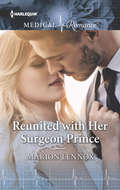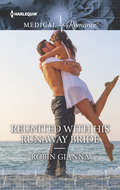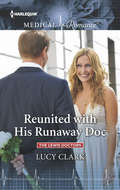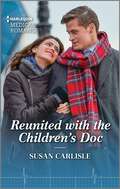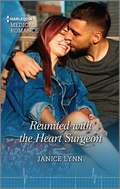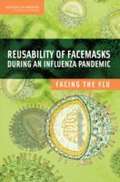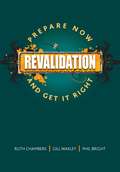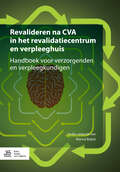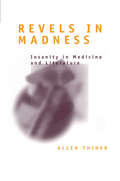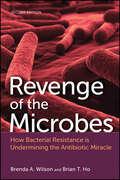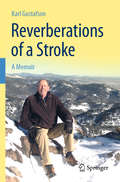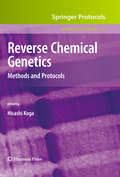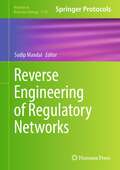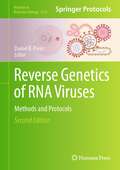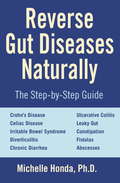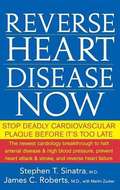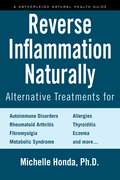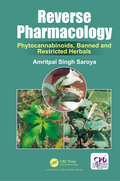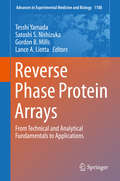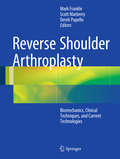- Table View
- List View
Reunited with Her Off-Limits Surgeon
by Amy RuttanReunited with her first love…and their attraction is still electrifying! Discover more in Amy Ruttan's latest story for Harlequin Medical Romance. One stolen night—and ten years later… Deaf audiologist Maeve hasn&’t seen Finn since their stolen night ten years ago. Now he&’s her hospital&’s temporary ENT surgeon—and sparks are still flying! Finn&’s only returned long enough to learn sign language for his dream job. Maeve&’s always craved adventure, but has people who depend on her. Unable to leave and protective of her emotions, she knows a relationship with Finn is off-limits! But denying their attraction has never been easy…From Harlequin Medical: Life and love in the world of modern medicine.
Reunited with Her Parisian Surgeon
by Annie O'NeilRaphael’s heart was lost… Until he found Maggie again! Brooding surgeon Dr. Raphael Boucher finds his way to Sydney and the one woman he could never forget. Working together it’s clear Maggie Louis is the only one who can make him feel alive again. But first Raphael must return to Paris and resolve his past before they can finally be together.
Reunited with Her Secret Prince: The Doctor's One Night To Remember / Reunited With Her Secret Prince (Mills And Boon Medical Ser.)
by Susanne HamptonSecond chance with a doctor…Forever with a prince!Four years ago, Dr. Daniel Dimosa disappeared and left nurse Libby McDonald with a broken heart…and a tiny life growing inside her. Now, unexpectedly reunited in the Caribbean, Libby’s in for another shock: Daniel, the father of her little boy, is a prince! Stuck together on assignment, Libby and Daniel discover that keeping the past in the past isn’t quite as easy as it sounds…From Harlequin Medical: Life and love in the world of modern medicine.
Reunited with Her Surgeon Prince
by Marion LennoxClaiming his secret heir-and his bride! Dr. Ellie Carson once married her secret prince, but then duty tore their whirlwind marriage apart-only, Ellie was also pregnant! Now surgeon and crown prince Marc Falken is soon to become king-and he's discovered he has a son! Claiming his heir means seeking out Ellie-the woman he's never stopped loving. But can Marc convince Ellie that she can be a doctor and his queen, and that finally they can become the family they were always meant to be?
Reunited with His Long-Lost Nurse (The Island Clinic #4)
by Charlotte HawkesAn unexpected reunion……in paradise!Leading heart surgeon Liam Miller has come to St. Victoria to perform lifesaving surgery. He never imagined the distraction of bumping into the woman who loved him and then left him without a word! Avoiding nurse Talia Johnson is far harder than he thought—especially when their inconvenient but still-burning attraction keeps boiling over! As their painful secrets come tumbling out, are they ready to finally confront the truth?A The Island Clinic novel The Island Clinic quartetBook 1 - How to Win the Surgeon's Heart by Tina BeckettBook 2 - Caribbean Paradise, Miracle Family by Julie DanversBook 3 - The Princess and the Pediatrician by Annie O&’NeilBook 4 - Reunited with His Long-Lost Nurse by Charlotte Hawkes &“I loved this book! I love both of the two main characters and boy oh boy did they have some steamy chemistry! I loved watching their relationship unfold and seeing them overcome their challenges. The Doctor&’s One Night To Remember was a fast steamy read that had a nice new twist on the medical romance trope. This is definitely one I would recommend!&”-Harlequin Junkie &“The medical dramas are outstanding and action packed. Couldn&’t fault them. They were interesting, sharp and action packed! I literally felt front-line! The humor sprinkled through the story was genius. This author absolutely 100% nailed it!&”-Harlequin Junkie on Reawakened by Her Army Major
Reunited with His Runaway Bride
by Robin GiannaBrought back together by a baby It broke Dr. Bree Donovan's heart to end things with family-orientated surgeon Sean Latham, but marriage and kids are not for her. Only, now Sean is asking her to help care for his newborn nephew while his sister is in hospital, and Bree can't say no. It's temporary, but as Bree experiences how rewarding family life can be-and gives in to the passion she and Sean have always shared-is it possible for her to believe that this time around they really could have it all?
Reunited with His Runaway Doc
by Lucy ClarkCan his love free her from her past? After years in witness protection, Dr. Maybelle Freebourne has come home-under a different identity. But, on her first day at Victory Hospital, she walks right into the boy she left behind, now director of Emergency and more gorgeous than ever! Arthur Lewis can't shake the feeling he knows the beautiful new doctor, and a stolen kiss reveals she really is the girl he's never forgotten. But can he convince Maybelle she is finally safe-in his arms?
Reunited with the Children's Doc (Atlanta Children's Hospital #1)
by Susan CarlisleWhen two broken hearts find each other again, will they have the courage to risk it all for a happy-ever-after? Find out what happens in Susan Carlisle&’s latest Harlequin Medical Romance book. He loved her once…Can he risk falling for her again? Since losing her son, Marcy has had a single focus: researching a cure for cancer. Meeting Dr. Dylan again is unexpected, and his compassionate warmth invades the fortress around her heart. Marcy&’s even more beautiful than he remembers, but Dylan&’s been abandoned too many times. As they fight for their patients&’ lives, an irresistible passion flares between them. Dare they put themselves on the line again for a shot at happy-ever-after?From Harlequin Medical: Life and love in the world of modern medicine.Atlanta Children's Hospital
Reunited with the Heart Surgeon
by Janice LynnLife pulled them apart……Can fate bring them back together?The minute nurse Natalie met Dr. Will, it was love. Still, that didn&’t make the constant disapproval from Will&’s wealthy family any easier to bear… At breaking point, Natalie ended their relationship. So, when they&’re tasked with planning a charity gala—together!—Natalie is stunned. How can she work with the man she never stopped loving? And what happens when one last night leads to a lifetime of consequences? &“...Ms. Lynn has delivered a marvelous and extremely engaging read in this book where the chemistry between this couple is off-the-charts….&”-Harlequin Junkie on Friend, Fling, Forever? &“…it&’s a story that encompasses plenty of emotion that I could feel along with the characters…the romance shows how good these two are together….&”-Harlequin Junkie on A Surgeon to Heal Her Heart
Reusability Of Facemasks During An Influenza Pandemic: Facing The Flu
by Institute of Medicine of the National AcademiesThe National Academies Press (NAP)--publisher for the National Academies--publishes more than 200 books a year offering the most authoritative views, definitive information, and groundbreaking recommendations on a wide range of topics in science, engineering, and health. Our books are unique in that they are authored by the nation's leading experts in every scientific field.
Revalidation: Prepare Now and Get it Right
by Ruth Chambers Gill Wakley Alison MagnallThis won't hurt a bit...How do you show that you consistently provide high quality clinical care both as an individual doctor and member of a team? How do you provide convincing evidence of your performance that justifies you as being fit to practise? And how do you achieve this in a way that is not too burdensome?Revalidation will now be more stringent that ever. You might need help gathering information so that your evidence is sufficiently robust and objective, presenting it so that addresses the fields in the General Medical Council's document. You'll need to make sure you match your portfolio with what is expected in your specialty area.This book helps you to sustain your energy in gathering and reviewing evidence of your day-to-day performance at work so that you are recertified and relicensed with ease, whatever future revisions are made to the revalidation process. By suggesting proactive and structured methods, this book offers easy to comprehend ways to guide you through the evidence cycle, with many examples in both clinical and non-clinical fields. It is ideal for primary care and hospital doctors preparing for revalidation, including trainee doctors. Appraisers, and trainee appraisers in trusts, deaneries or general practice will find the guidance invaluable, as will appraisal leads in healthcare organisations and those with responsibility for quality assurance of appraisal as part of clinical governance or regulation.
Revalideren na CVA in het revalidatiecentrum en verpleeghuis
by Bianca BuijckVerzorgenden en verpleegkundigen hebben een belangrijke taak bij de revalidatie, voorlichting, preventie, verzorging en begeleiding van patiënten met een Cerebro Vasculair Accident (CVA). De zorgverlening aan deze patiënten is specifiek en daarvoor is deskundigheid vereist die verder gaat dan algemene neurologische kennis en ervaring. Verder moeten ze op een effectieve en efficiënte wijze samenwerken met verschillende professionals zowel binnen als buiten de eigen instelling. Dit boek biedt daarom een integrale kennis van alle aspecten van de behandeling, verzorging en begeleiding van patiënten met een CVA. De eerste hoofdstukken behandelen de medische aspecten en specifieke symptomen na een CVA, de daaruit volgende beperkingen en welke interventies zicht bieden op herstel van functies. Vervolgens komen de verschillende fasen na een CVA aan de orde, zoals welke zorg patiënten ontvangen in de chronische fase. Met dit boek doen de verzorgende en verpleegkundige ook kennis op over het belang van observeren, de behandeling en begeleiding bij communicatieproblemen, slikproblematiek, ADL, blaas-darmproblematiek, revaliderend MDT en schouder-hand problematiek. Met behulp van foto’s wordt uitgelegd hoe verzorgenden en verpleegkundigen patiënten kunnen verplaatsen. In de verschillende hoofdstukken vinden verzorgenden en verpleegkundigen uitleg over het effectief en efficiënt samenwerken met verschillende professionals zowel binnen als buiten de eigen instelling, evenals met de naasten en mantelzorgers van de CVA-patiënt. Ook gaat het boek in op de psychosociale problematiek van de patiënt na een CVA, zoals gedrag en cognitie. De laatste twee hoofdstukken gaan in op de organisatie van zorg na een CVA: de organisatie op de revalidatieafdeling en in de ketensamenwerking. In het boek zijn er tal van voorbeelden te vinden die de lesstof begrijpelijker maken. Dit boek is geschikt voor verzorgenden en verpleegkundigen die (gaan) werken op een specifieke CVA-revalidatieafdeling in een verpleeghuis of revalidatiecentrum.
Revels in Madness: Insanity in Medicine and Literature
by Allen ThiherIn Revels in Madness, Allen Thiher surveys a remarkable range of writers as he shows how conceptions of madness in literature have reflected the cultural assumptions of their era. Thiher underscores the transition from classical to modern theories of madness-a transition that began at the end of the Enlightenment and culminates in recent women's writing that challenges the postmodern understanding of madness as a fall from language or as a dysfunction of culture.
Revenge of the Microbes: How Bacterial Resistance is Undermining the Antibiotic Miracle (ASM Books)
by Brenda A. Wilson Brian T. HoRevenge of the Microbes “What is antibiotic resistance, and why should I care?” Two decades after the first edition of Revenge of the Microbes: How Bacterial Resistance Is Undermining the Antibiotic Miracle warned of the looming threat of antibiotic resistance, it is now upon us. Not only has the spread of antibiotic resistance continued unabated, but the emergence of multidrug-resistant “superbugs” is poised to set medical progress back centuries. Several distinct biological, social, economic, and technological factors have resulted in us only barely keeping pace with these new threats. In this edition of Revenge of the Microbes, the authors detail the intricacies of the antibiotic-microbe arms race. Beginning with a historical perspective on antibiotics and their profound impact on both modern medicine and present-day society, they review our current arsenal against infectious diseases and the various ways pathogens evade or overcome them. The authors examine the practices and policies driving the discovery and development of new antibiotics, what happens to antibiotics once they are released into the environment, how antibiotic-resistant bacteria evolve and spread, and the urgency for finding alternative approaches to combating infections. This discussion of the controversies surrounding antibiotics will empower readers—citizen scientists, policy makers, pharmaceutical researchers, and medical professionals alike—to generate informed opinions on antibiotic usage and stewardship as we contend with fewer effective antibiotics. Reader-friendly and comprehensible, this new edition of Revenge of the Microbes engages a diverse audience of scientists, clinicians, educators, students, lawyers, environmentalists, and public health advocates as it explores the ever-changing landscape of the antibiotic resistance crisis. For anyone interested in antimicrobial resistance (AMR), this is a completely approachable 360-degree view of a very complex topic. The authors don’t dilute the science but manage to deliver it in language and examples that everyone can digest. Don’t miss the “Points to Ponder” at the end of each chapter. These thought-provoking nuggets will inspire creative thinking even in the most experienced AMR authorities. — JEAN B. PATEL, PhD, D(ABMM), Principle Scientist, Scientific Affairs, Microbiology, Beckman Coulter; former Science Team Lead, Antibiotic Resistance Coordination and Strategy Unit, CDC
Revenge of the Windigo
by James WaldramWhat is known about Aboriginal mental health and mental illness, and on what basis is this 'knowing' assumed? This question, while appearing simple, leads to a tangled web of theory, method, and data rife with conceptual problems, shaky assumptions, and inappropriate generalizations. It is also the central question of James Waldram's Revenge of the Windigo.This erudite and highly articulate work is about the knowledge of Aboriginal mental health: who generates it; how it is generated and communicated; and what has been ? and continues to be ? its implications for Aboriginal peoples. To better understand how this knowledge emerged, James Waldram undertakes an exhaustive examination of three disciplines ? anthropology, psychology, and psychiatry ? and reveals how together they have constructed a gravely distorted portrait of 'the Aboriginal.'Waldram continues this acute examination under two general themes. The first focuses on how culture as a concept has been theorized and operationalized in the study of Aboriginal mental health. The second seeks to elucidate the contribution that Aboriginal peoples have inadvertently made to theoretical and methodological developments in the three fields under discussion, primarily as subjects for research and sources of data. It is Waldram's assertion that, despite the enormous amount of research undertaken on Aboriginal peoples, researchers have mostly failed to comprehend the meaning of contemporary Aboriginality for mental health and illness, preferring instead the reflection of their own scientific lens as the only means to properly observe, measure, assess, and treat.Using interdisciplinary methods, the author critically assesses the enormous amount of information that has been generated on Aboriginal mental health, deconstructs it, and through this exercise, provides guidance for a new vein of research.
Reverberations of a Stroke: A Memoir
by Karl GustafsonIn the early morning hours of Feb. 1, 2016, Karl Gustafson became instinctively aware that something catastrophic was happening inside him. A severe headache that had persisted for days had taken a sudden turn for the worse, and a clear inner voice ordered him to obtain immediate help. With determined effort, he tapped out the digits “9-1-1” on his phone—bringing an ambulance to his door quickly and saving his life. Emergency Room doctors would soon learn that Professor Gustafson, a renowned American mathematician, had suffered a deep brain hemorrhage, and that the situation was dire. By the time his condition was diagnosed, blood had pooled into all four ventricles of Gustafson’s brain and he was comatose. Against all odds and surprising everyone, the author emerged from a near-death state to go on to what he calls his “Second Life”. This is the story of his miraculous journey of recovery, an inspirational tale of grit and determination, in his own words.
Reverse Chemical Genetics
by Hisashi KogaNow a major approach in the identification of certain gene product functions, reverse chemical genetics allows the identification of target genes to precede phenotypic changes created by specific small molecules. In Reverse Chemical Genetics: Methods and Protocols, expert authors introduce fundamental resources, including databases for reverse chemical genetics, as well as the modification of these cDNA resources by the most recent molecular technologies. The book explores newly established methods in addition to potentially applicable techniques that make use of specific small molecules, plus functional assays utilizing these molecules, while focusing on methods that make feasible the functional discovery and comprehensive knowledge of particular target genes. As a volume in the highly successful Methods in Molecular BiologyTM series, chapters contain introductions to their respective topics, lists of the necessary materials and reagents, step-by-step, readily reproducible laboratory protocols, and notes on troubleshooting and avoiding known pitfalls. Authoritative and cutting-edge, Reverse Chemical Genetics: Methods and Protocols promises to inspire researchers to conduct their own experiments in order to progress this vital field of study.
Reverse Engineering of Regulatory Networks (Methods in Molecular Biology #2719)
by Sudip MandalThis volume details the development of updated dry lab and wet lab based methods for the reconstruction of Gene regulatory networks (GRN). Chapters guide readers through culprit genes, in-silico drug discovery techniques, genome-wide ChIP-X data, high-Throughput Transcriptomic Data Exome Sequencing, Next-Generation Sequencing, Fuorescence Spectroscopy, data analysis in Bioinformatics, Computational Biology, and S-system based modeling of GRN. Written in the highly successful Methods in Molecular Biology series format, chapters include introductions to their respective topics, lists of the necessary materials and reagents, step-by-step, readily reproducible laboratory protocols, and key tips on troubleshooting and avoiding known pitfalls. Authoritative and cutting-edge, Reverse Engineering of Regulatory Networks aims to be a useful and practical guide to new researchers and experts looking to expand their knowledge.
Reverse Genetics of RNA Viruses: Methods and Protocols (Methods in Molecular Biology #2733)
by Daniel R. PérezThis second edition volume expands on the previous edition with new and updated chapters that highlight the latest methods and approaches for the manipulation of RNA viruses. The chapters in this book explore the fundamental role in studying RNA viruses; identifying markers of host range, disease, and transmission; and aid readers with the further development of in silico computational biology tools and artificial intelligence algorithms that can help predict the emergence of certain pathogens. Written in the highly successful Methods in Molecular Biology series format, chapters include introductions to their respective topics, lists of the necessary materials and reagents, step-by-step, readily reproducible laboratory protocols, and tips on troubleshooting and avoiding known pitfalls.Cutting-edge and comprehensive, Reverse Genetics of RNA Viruses: Methods and Protocols, Second Edition is a valuable resource for researchers who are interested in learning more about this developing field.
Reverse Gut Diseases Naturally: Cures for Crohn's Disease, Ulcerative Colitis, Celiac Disease, IBS, and More
by Ellen Tart-Jensen Michelle HondaThe Long-Awaited Resource for Those Seeking to Reverse Gut Disease—Naturally.<P><P> More than 50 million Americans struggle with gut diseases like Crohn’s disease and colitis. With traditional medicine offering little in the way of lasting, low-risk solutions, more patients are turning to the world of natural medicine. With Reverse Gut Diseases Naturally, learn to work with your body to achieve safe and sustainable results that will let you reclaim your life and your independence.<P> Reverse Gut Diseases Naturally contains step by step, do-it-yourself instructions to help you reverse gut disorders and restore health. Complete with healing remedies, dietary regimens, and protocols for every stage of healing and maintenance, Reverse Gut Diseases Naturally also includes the most effective dietary programs proven to help treat gut dysbiosis and other intestinal ailments.<P> Featuring alternative solutions to potentially harmful prescription drugs, as well as safe food choices and a guide to herbal medicine, Reverse Gut Diseases Naturally helps you regain your sense of health and wellbeing.<P> Touching on every aspect of gut disease, including: risk factors and common causes of gut disease; supporting your body and its glandular health; holistic approaches to treating gut disease, and much more, Reverse Gut Diseases Naturally is the all-in-one resource for those looking to find something that really works.<P> Reverse Gut Diseases Naturally covers a multitude of topics, including:<P> • A complete dietary program for gut wellness, including a Quick Start Program<P> • Natural substitutes for popular over-the-counter and prescription medications<P> • The current issue of antibiotic use and overuse, and its role in gut disease<P> • Detailed case histories demonstrating the effectiveness of natural methods each step of the way<P> • How best to prepare herbal remedies and supplements for a variety of uses<P> ...and many more!<P> Diseases of the gut can be among the most limiting and life-altering conditions possible. Don’t just settle for keeping your symptoms under control—reverse your gut disease, the natural way!
Reverse Heart Disease Now: Stop Deadly Cardiovascular Plaque Before It's Too Late
by Martin Zucker Stephen T. Sinatra James C. RobertsWhile most books focus solely on the role of cholesterol in heart disease, "Reverse Heart Disease Now "draws on new research that points to the surprising other causes. Two leading cardiologists draw on their collective fifty years of clinical cardiology research to show you how to combine the benefits of modern medicine, over-the-counter vitamins and supplements, and simple lifestyle changes to have a healthy heart.
Reverse Inflammation Naturally: Alternative Treatments for Autoimmune Disorders, Rheumatoid Arthritis, Fibromyalgia, Metabolic Syndrome, Allergies, Thyroiditis, Eczema and more.
by Michelle HondaReverse Inflammation Naturally provides a comprehensive overview of both acute and chronic inflammation and offers practical guidance and alternative solutions to popular drugs as well as beneficial supplements and home remedies.Chronic inflammation is among the most prevalent ailments seen in modern society—and all too often, our diet and reliance on common over-the-counter medications is to blame. Not only does traditional medicine offer little in the way of safe, low-risk solutions, it is one of the leading causes of painful, unnecessary inflammation in patients of all ages. As a result, more patients are turning to the world of natural medicine. With Reverse Inflammation Naturally, you can learn how to work with your body to achieve effective healing, see lasting results, and reclaim your life.Complete with healing remedies, dietary regimens, and protocols for every stage of healing and maintenance, Reverse Inflammation Naturally contains step-by-step, do-it-yourself instructions and includes the most effective dietary programs and herbal supplements proven to help control—and reverse—the body’s inflammation response, all while promoting overall health and wellness.Reverse Inflammation Naturally covers a multitude of topics, including: • A comprehensive overview of inflammation, its causes, and its related ailments • Natural substitutes for popular over-the-counter and prescription medications • How best to prepare herbal remedies and supplements for a variety of uses • The latest information on clinical trials, medications, and alternative therapies • How to select the right supplements, vitamins, and nutrients for your needs …and many more!Featuring alternative solutions to potentially harmful prescription drugs, as well as safe food choices and a guide to herbal medicine, Reverse Inflammation Naturally helps you regain your sense of health and well-being.
Reverse Pharmacology: Phytocannabinoids, Banned and Restricted Herbals
by Amritpal Singh SaroyaReverse Pharmacology: Phytocannabinoids, Banned and Restricted Herbals will serve as a tailormade reference guide for the manufacturers and practitioners of herbal drugs. Part A deals with Reverse Pharmacology & Nanophytomedicine and Part B with Phytocannabinoids and description of banned or restricted herbal drugs. Part B also includes chemical structures and unpublished material which are the salient features of this book. The work is an invaluable resource for professionals in the manufacturing of herbal and pharmaceutical products as well as those persons in regulatory affairs.
Reverse Phase Protein Arrays: From Technical and Analytical Fundamentals to Applications (Advances in Experimental Medicine and Biology #1188)
by Lance A. Liotta Tesshi Yamada Satoshi S. Nishizuka Gordon B. MillsThis book provides practical guidance on all aspects of reverse phase protein array (RPPA) technology, which permits the quantification of protein levels in cell or tissue lysates. In addition, the latest results are presented from laboratories across the world where experts are successfully running the challenging RPPA data platform. After an introductory chapter by the inventor of the RPPA technique, the demanding task of lysate preparation is explained. Subsequent chapters review printing platforms and analytical platforms and discuss antibody screening in detail. The role of RPPA data in integrative analyses is thoroughly examined, and the various applications of RPPA, for example to identify molecular targeting drugs or evaluate cancer drug efficacy, are discussed with reference to the latest knowledge. It is hoped that the book will foster the implementation of RPPA by documenting the practical details of the technology and by revealing its great potential. It will be of high value for researchers who plan to build an RPPA platform in their institute and for researchers, clinicians, and companies who use RPPA through collaboration with an existing RPPA facility.
Reverse Shoulder Arthroplasty
by Mark Frankle Scott Marberry Derek PupelloFocusing exclusively on reverse shoulder arthroplasty (RSA) techniques and devices, this plentifully illustrated text covers all aspects of this important and innovative treatment for shoulder pain and dysfunction. The book begins with a history of RSA followed by a thorough overview of the basic science and biomechanics of the shoulder. Indications for and clinical applications of RSA in a number of surgical interventions are then described, including the revision of failed shoulder arthroplasty, setting in cases of glenoid and humeral bone loss and rotator cuff tears. A whole section is then dedicated to various commercial devices with descriptive expert analysis of the design and implementation of each. An examination of the current economic value of RSA, including cost effectiveness and expected cost outcomes, comprises the final section. Reverse Shoulder Arthroplasty can therefore be read either from start to finish, allowing orthopedic surgeons to appreciate the various perspectives offered, or by selecting specific topics of interest much like a "how-to manual" of either a particular device design or the treatment of a specific pathology.



